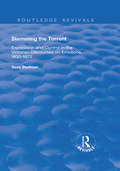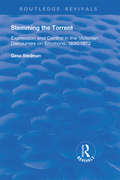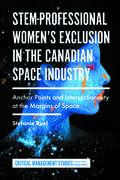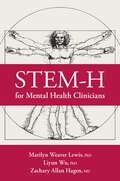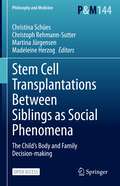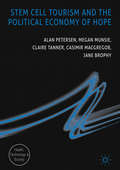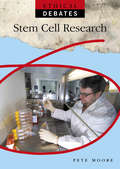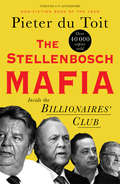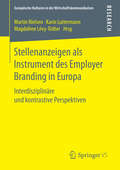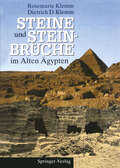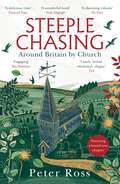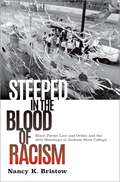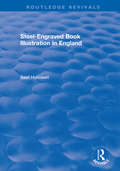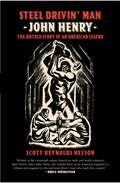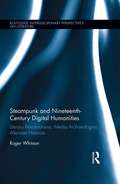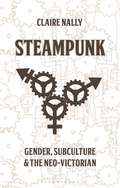- Table View
- List View
Stemming the Torrent: Expression and Control in the Victorian Discourses on Emotion, 1830-1872 (Routledge Revivals)
by Gesa StedmanThis title was first published in 2002: Gesa Stedman mines the vein of emotion in Victorian writing to unearth new insights into the ways literature responded to the dramatic social and political changes then taking place. Contemporary research from various disciplines, including sociology, ethnology and history, inform this study, which juxtaposes canonical material such as Dickens' "Hard Times", Charlotte Bronte's "Shirley" and Germaine de Stael's "Corinne" with popular novels and non-fictional texts, such as "The Education of the Heart" by Sarah Ellis and Darwin's "On the Expression of the Emotions in Man and Animals". The analysis deals with emotions applying to both genders, but includes a special section examining the representation of emotion in relation to women. The book aims to provide new insight into the literature of the period, and brings to light new material for scholars interested in the philosophy and psychology of emotions.
Stemming the Torrent: Expression and Control in the Victorian Discourses on Emotion, 1830-1872 (Routledge Revivals)
by Gesa StedmanThis title was first published in 2002: Gesa Stedman mines the vein of emotion in Victorian writing to unearth new insights into the ways literature responded to the dramatic social and political changes then taking place. Contemporary research from various disciplines, including sociology, ethnology and history, inform this study, which juxtaposes canonical material such as Dickens' "Hard Times", Charlotte Bronte's "Shirley" and Germaine de Stael's "Corinne" with popular novels and non-fictional texts, such as "The Education of the Heart" by Sarah Ellis and Darwin's "On the Expression of the Emotions in Man and Animals". The analysis deals with emotions applying to both genders, but includes a special section examining the representation of emotion in relation to women. The book aims to provide new insight into the literature of the period, and brings to light new material for scholars interested in the philosophy and psychology of emotions.
Stemming the Torrent: Expression and Control in the Victorian Discourses on Emotion, 1830-1872 (Routledge Revivals Ser.)
by Gesa StedmanThis title was first published in 2002: Gesa Stedman mines the vein of emotion in Victorian writing to unearth new insights into the ways literature responded to the dramatic social and political changes then taking place. Contemporary research from various disciplines, including sociology, ethnology and history, inform this study, which juxtaposes canonical material such as Dickens' "Hard Times", Charlotte Bronte's "Shirley" and Germaine de Stael's "Corinne" with popular novels and non-fictional texts, such as "The Education of the Heart" by Sarah Ellis and Darwin's "On the Expression of the Emotions in Man and Animals". The analysis deals with emotions applying to both genders, but includes a special section examining the representation of emotion in relation to women. The book aims to provide new insight into the literature of the period, and brings to light new material for scholars interested in the philosophy and psychology of emotions.
STEM-Professional Women's Exclusion in the Canadian Space Industry: Anchor Points and Intersectionality at the Margins of Space (Critical Management Studies)
by Stefanie RuelSTEM-Professional Women’s Exclusion in the Canadian Space Industry: Anchor Points and Intersectionality at the Margins of Space showcases the ‘how’ of exclusion of STEM-professional women from management and executive positions. It examines the discourses and power-relations surrounding these STEM-professional women’s identities, drawing on and reworking the concept of anchor points to investigate their relationship to structural, discursive, and socio-psychological processes. By utilizing the critical sensemaking (CSM) framework, the book provides an avenue to surface the ephemeral identities of STEM-professional women, and investigate their relationship with the meta-rules, rules, and social values of the Canadian space industry. It also considers the potential for social change across this industry by considering the responsibilities of cisgender men with respect to addressing and resisting the systemic discrimination of STEM-professional women in the industry. Specific sites for micro-political resistances that these STEM-professional women could enact are considered and suggested. This book will appeal to researchers and scholars focused on gender and diversity, intersectionality scholarship, and poststructuralist intersectional feminism.
STEM-Professional Women's Exclusion in the Canadian Space Industry: Anchor Points and Intersectionality at the Margins of Space (Critical Management Studies)
by Stefanie RuelSTEM-Professional Women’s Exclusion in the Canadian Space Industry: Anchor Points and Intersectionality at the Margins of Space showcases the ‘how’ of exclusion of STEM-professional women from management and executive positions. It examines the discourses and power-relations surrounding these STEM-professional women’s identities, drawing on and reworking the concept of anchor points to investigate their relationship to structural, discursive, and socio-psychological processes. By utilizing the critical sensemaking (CSM) framework, the book provides an avenue to surface the ephemeral identities of STEM-professional women, and investigate their relationship with the meta-rules, rules, and social values of the Canadian space industry. It also considers the potential for social change across this industry by considering the responsibilities of cisgender men with respect to addressing and resisting the systemic discrimination of STEM-professional women in the industry. Specific sites for micro-political resistances that these STEM-professional women could enact are considered and suggested. This book will appeal to researchers and scholars focused on gender and diversity, intersectionality scholarship, and poststructuralist intersectional feminism.
STEM-H for Mental Health Clinicians
by Marilyn Weaver Lewis Liyun Wu Zachary A. HagenSTEM-H for Mental Health Clinicians introduces a new model that adapts scientific, technological, engineering, and mathematical concepts to treat the health (STEM-H) of patients with medical problems. The book begins with a discussion of genetics and continues through current scientific research underlying each bodily system to inform practitioners and advanced students about development, as well as structure, and function. Signature illnesses and injuries that affect each system are discussed at length, as well as technological advances and biomedical engineering that developed apparatuses and medications to treat those signature conditions. Mathematical concepts that underlie public health models are introduced in each chapter and range from the prevalence and incidence of these medical conditions to social determinants of health, and the relationship of ethnicity, gender, and poverty. Clinical theories and methods are introduced to inform practitioners about treatments of signature illnesses and injuries experienced by children and adults. The book thoroughly explains the terminology and STEM-H concepts to inform students and mental health clinicians. Readers who master the material will be prepared to work as medical team members or as independent clinicians with private or community clients who struggle with medical problems. This textbook addresses the well-being of the patient's family members and introduces solutions to improve the caregivers' burden. Chapters in STEM-H for Clinicians provide a bench-side to bedside approach to apply basic global scientific data, predominantly from the United States, that inform clinicians' treatment methods and develop research-informed practice.
STEM-H for Mental Health Clinicians
by Marilyn Weaver Lewis Liyun Wu Zachary A. HagenSTEM-H for Mental Health Clinicians introduces a new model that adapts scientific, technological, engineering, and mathematical concepts to treat the health (STEM-H) of patients with medical problems. The book begins with a discussion of genetics and continues through current scientific research underlying each bodily system to inform practitioners and advanced students about development, as well as structure, and function. Signature illnesses and injuries that affect each system are discussed at length, as well as technological advances and biomedical engineering that developed apparatuses and medications to treat those signature conditions. Mathematical concepts that underlie public health models are introduced in each chapter and range from the prevalence and incidence of these medical conditions to social determinants of health, and the relationship of ethnicity, gender, and poverty. Clinical theories and methods are introduced to inform practitioners about treatments of signature illnesses and injuries experienced by children and adults. The book thoroughly explains the terminology and STEM-H concepts to inform students and mental health clinicians. Readers who master the material will be prepared to work as medical team members or as independent clinicians with private or community clients who struggle with medical problems. This textbook addresses the well-being of the patient's family members and introduces solutions to improve the caregivers' burden. Chapters in STEM-H for Clinicians provide a bench-side to bedside approach to apply basic global scientific data, predominantly from the United States, that inform clinicians' treatment methods and develop research-informed practice.
Stem Cell Transplantations Between Siblings as Social Phenomena: The Child’s Body and Family Decision-making (Philosophy and Medicine #144)
by Christina Schües Christoph Rehmann-Sutter Martina Jürgensen Madeleine HerzogThis open access book offers insights in short- and long-term experiences from families with bone marrow transplantations between minor siblings. It is based on the first extended qualitative study with 17 families about experiences with recent transplants and experiences with transplants up to 20 years in the past. It covers reflections of donors, recipients and other family members, as well as family interactions. Transplantation of bone marrow from one sibling to another who is ill with a blood cancer (such as Leukemia) is a life-saving therapy. Young children however are not in a position to give consent themselves. How should they be adequately included, depending to their age? Which ethical questions are raised for the parents both at the time of treatment and afterwards, and for the medical professionals in clinical and regulatory contexts? For an in-depth discussion of the findings the books brings together a group of leading scholars from the fields of bioethics, family sociology and philosophy of medicine.
Stem Cell Tourism and the Political Economy of Hope (Health, Technology and Society)
by Alan Petersen Megan Munsie Claire Tanner Casimir Macgregor Jane BrophyThis book provides a unique and innovative perspective on the controversial phenomenon of ‘stem cell tourism’. A growing number of patients are embarking on stem cell treatments that are clinically unproven and yet available in clinics and hospitals around the world. The authors offer a cutting-edge multi-dimensional perspective on this complex and rapidly changing phenomenon, including an analysis of the experiences of those who have undertaken or have contemplated undertaking a stem cell treatment, as well as examination of the views of those who undertake research or advise on or provide stem cell treatments. Developing the concept of ‘the political economy of hope’, and referencing case studies of the stem cell treatment market in China, Germany, and Australia, this book argues for a reframing of ‘stem cell tourism’ to understand why patients and families pursue these treatments and whether authorities’ concerns are justified and whether their responses are appropriate and proportionate to the alleged risks.
Stem Cell Research: Stem Cell Research (Ethical Debates #18)
by Pete MooreThis series shows balanced arguments for and against issues affecting our modern world. The books study each argument in detail and explore the history of each topic. The use of case studies throughout bring the issues to light.
The Stellenbosch Mafia: Inside the Billionaire’s Club
by Pieter du ToitAbout 50km outside of Cape Town lies the beautiful town of Stellenbosch, nestled against vineyards and blue mountains that stretch to the sky. Here reside some of South Africa’s wealthiest individuals: all male, all Afrikaans – and all stinking rich. Johann Rupert, Jannie Mouton, Markus Jooste and Christo Weise, to name a few.Julius Malema refers to them scathingly as ‘The Stellenbosch Mafia’, the very worst example of white monopoly capital. But who really are these mega-wealthy individuals, and what influence do they exert not only on Stellenbosch but more broadly on South African society?Author Pieter du Toit begins by exploring the roots of Stellenbosch, one of the wealthiest towns in South Africa and arguably the cradle of Afrikanerdom. This is the birthplace of apartheid leaders, intellectuals, newspaper empires and more.He then closely examines this ‘club’ of billionaires. Who are they and, crucially, how are they connected? What network of boardroom membership, alliances and family connections exist? Who are the ‘old guard’ and who are the ‘inkommers’, and what about the youngsters desperate to make their mark? He looks at the collapse of Steinhoff: what went wrong, and whether there are other companies at risk of a similar fate. He examines the control these men have over cultural life, including pulling the strings in South Africa rugby.
Stellenanzeigen als Instrument des Employer Branding in Europa: Interdisziplinäre und kontrastive Perspektiven (Europäische Kulturen in der Wirtschaftskommunikation #23)
by Martin Nielsen Magdalène Lévy-Tödter Karin LuttermannDer Band versammelt Studien zum Thema Stellenanzeige aus sprach-, kultur-, marketingwissenschaftlicher und juristischer Perspektive, die eine differenzierte Herangehensweise an diese Textsorte im Rahmen des Human Resource Management ermöglichen. Untersucht werden im interdisziplinären Zusammenspiel Funktionen und Wirkungsmittel von Stellenanzeigen im europäischen Kontext des Employer Branding. Die Beiträge zeigen, dass Unternehmen im verschärften Wettbewerb um hochqualifizierte Mitarbeiter viele Möglichkeiten haben, sich als attraktiver Arbeitgeber zu positionieren.
Steine und Steinbrüche im Alten Ägypten
by Rosemarie Klemm Dietrich D. KlemmAusgehend von der geologischen Struktur Oberägyptens und der mineralogischen Zusammensetzung der Gesteine gehen die Autoren mit reichhaltigem Bildmaterial auf Spurensuche in alten ägyptischen Steinbrüchen. Detaillierte Beschreibungen der Steinbrüche, zahlreiche Beispiele für Steinbruch- und Steinmetztechniken, Dünnschliff- und Rasterelektronenaufnahmen sowie Farbtafeln von allen beschriebenen Gesteinen machen das Buch zu einem unentbehrlichen Hilfsmittel bei der Herkunftsbestimmung von in Museen ausgestellten Exponaten. Archäologen und Ägyptologen, Ägyptenreisende und -interessierte finden eine Fülle von interessanten Informationen über antike Steinbruchanlagen, Transport- und Abbaumethoden im alten Ägypten und nebenbei noch eine Einführung in die Geologie und Mineralogie des oberen Niltales.
Steeple Chasing: Around Britain by Church
by Peter Ross'What makes Steeple Chasing so compelling - and it is a wonderful book; thoughtful and challenging - is Ross's essential kindness, his unfailing empathy with the people he meets on his pilgrimage.' - Daily Telegraph *****'Steeple Chasing is a beautiful and brilliant book; written with such care and deep, abiding interest in its subject matter as to entrance the enthusiast and amateur alike. I loved it.' - Fergus Butler-Gallie'Ross has always had a quiet charm, and it is perhaps displayed best in this book. ' - The Scotsman From the author of A Tomb With a View - Scottish Non-Fiction book of the Year Churches are all around us. Their steeples remain landmarks in our towns, villages and cities, even as their influence and authority has waned. They contain art and architectural wonders - one huge gallery scattered, like a handful of jewels, across these isles.Award-winning writer Peter Ross sets out to tell their stories, and through them a story of Britain. Join him as he visits the unassuming Norfolk church which contains a disturbing secret, and London's mighty cathedrals with their histories of fire and love. Meet cats and bats, monks and druids, angels of oak and steel.Steeple Chasing, though it sometimes strikes an elegiac note, is a song of praise. It celebrates churches for their beauty and meaning, and for the tales they tell. It is about people as much as place, flesh and bone not just flint and stone. From the painted hells of Surrey to the holy wells of Wales, consider this a travel book . . . with bells on.Praise for Peter Ross'Ross is a wonderfully evocative writer, deftly capturing a sense of place and history, while bringing a deep humanity to his subject. He has written a delightful book.' - The Guardian'Fascinating . . . Ross makes a likeably idiosyncratic guide and one finishes the book feeling strangely optimistic about the inevitable.' - The Observer'The author's humanity has acted as a beacon of light in the darkness.' - The Sunday Times
Steeped in the Blood of Racism: Black Power, Law and Order, and the 1970 Shootings at Jackson State College
by Professor Nancy K. BristowMinutes after midnight on May 15, 1970, white members of the Jackson city police and the Mississippi Highway Patrol opened fire on young people in front of a women's dormitory at Jackson State College, a historically black college in Jackson, Mississippi, discharging "buckshot, rifle slugs, a submachine gun, carbines with military ammunition, and two 30.06 rifles loaded with armor-piercing bullets." Twenty-eight seconds later two young people lay dead, another 12 injured. Taking place just ten days after the killings at Kent State, the attack at Jackson State never garnered the same level of national attention and was chronically misunderstood as similar in cause. This book reclaims this story and situates it in the broader history of the struggle for African American freedom in the civil rights and black power eras. The book explores the essential role of white supremacy in causing the shootings and shaping the aftermath. By 1970, even historically conservative campuses such as Jackson State, where an all-white Board of Trustees of Institutions of Higher Learning had long exercised its power to control student behavior, were beginning to feel the impact of the movements for African American freedom. Though most of the students at Jackson State remained focused not on activism but their educations, racial consciousness was taking hold. It was this campus police attacked. Acting on racial animus and with impunity, the shootings reflected both traditional patterns of repression and the new logic and rhetoric of "law and order," with its thinly veiled racial coding. In the aftermath, the victims and their survivors struggled unsuccessfully to find justice. Despite multiple investigative commissions, two grand juries and a civil suit brought by students and the families of the dead, the law and order narrative proved too powerful. No officers were charged, no restitution was paid, and no apologies were offered. The shootings were soon largely forgotten except among the local African American community, the injured victimized once more by historical amnesia born of the unwillingness to acknowledge the essential role of race in causing the violence.
Steeped in the Blood of Racism: Black Power, Law and Order, and the 1970 Shootings at Jackson State College
by Professor Nancy K. BristowMinutes after midnight on May 15, 1970, white members of the Jackson city police and the Mississippi Highway Patrol opened fire on young people in front of a women's dormitory at Jackson State College, a historically black college in Jackson, Mississippi, discharging "buckshot, rifle slugs, a submachine gun, carbines with military ammunition, and two 30.06 rifles loaded with armor-piercing bullets." Twenty-eight seconds later two young people lay dead, another 12 injured. Taking place just ten days after the killings at Kent State, the attack at Jackson State never garnered the same level of national attention and was chronically misunderstood as similar in cause. This book reclaims this story and situates it in the broader history of the struggle for African American freedom in the civil rights and black power eras. The book explores the essential role of white supremacy in causing the shootings and shaping the aftermath. By 1970, even historically conservative campuses such as Jackson State, where an all-white Board of Trustees of Institutions of Higher Learning had long exercised its power to control student behavior, were beginning to feel the impact of the movements for African American freedom. Though most of the students at Jackson State remained focused not on activism but their educations, racial consciousness was taking hold. It was this campus police attacked. Acting on racial animus and with impunity, the shootings reflected both traditional patterns of repression and the new logic and rhetoric of "law and order," with its thinly veiled racial coding. In the aftermath, the victims and their survivors struggled unsuccessfully to find justice. Despite multiple investigative commissions, two grand juries and a civil suit brought by students and the families of the dead, the law and order narrative proved too powerful. No officers were charged, no restitution was paid, and no apologies were offered. The shootings were soon largely forgotten except among the local African American community, the injured victimized once more by historical amnesia born of the unwillingness to acknowledge the essential role of race in causing the violence.
Steel-Engraved Book Illustration in England (Routledge Revivals)
by Basil HunnisettFirst published in 1980, Steel-Engraved Book Illustration in England is a detailed and comprehensive survey of the steel engravings that were so popular in the nineteenth century. With an extensive range of illustrations, the book refutes the assumption that steel engravings are of little artistic value or importance, a common attitude rooted largely in the connection between steel engravings and mass-produced books. Beginning with an exploration of the identification problems and early history of steel engravings, it moves through the production and printing of the plates and on to a study of several engravers and artists, as well as of the books themselves. Steel-Engraved Book Illustration in England will appeal to anyone interested in the history of printing and illustration.
Steel-Engraved Book Illustration in England (Routledge Revivals)
by Basil HunnisettFirst published in 1980, Steel-Engraved Book Illustration in England is a detailed and comprehensive survey of the steel engravings that were so popular in the nineteenth century. With an extensive range of illustrations, the book refutes the assumption that steel engravings are of little artistic value or importance, a common attitude rooted largely in the connection between steel engravings and mass-produced books. Beginning with an exploration of the identification problems and early history of steel engravings, it moves through the production and printing of the plates and on to a study of several engravers and artists, as well as of the books themselves. Steel-Engraved Book Illustration in England will appeal to anyone interested in the history of printing and illustration.
Steel Drivin' Man: John Henry, The Untold Story of an American Legend
by Scott Reynolds NelsonThe ballad "John Henry" is the most recorded folk song in American history and John Henry--the mighty railroad man who could blast through rock faster than a steam drill--is a towering figure in our culture. In Steel Drivin' Man, Scott Reynolds Nelson recounts the true story of the man behind the iconic American hero, telling the poignant tale of a young Virginia convict who died working on one of the most dangerous enterprises of the time, the first rail route through the Appalachian Mountains. Using census data, penitentiary reports, and railroad company reports, Nelson reveals how John Henry, victimized by Virginia's notorious Black Codes, was shipped to the infamous Richmond Penitentiary to become prisoner number 497, and was forced to labor on the mile-long Lewis Tunnel for the C&O railroad. Equally important, Nelson masterfully captures the life of the ballad of John Henry, tracing the song's evolution from the first printed score by blues legend W. C. Handy, to Carl Sandburg's use of the ballad to become the first "folk singer," to the upbeat version by Tennessee Ernie Ford. Attractively illustrated with numerous images, Steel Drivin' Man offers a marvelous portrait of a beloved folk song--and a true American legend.
Steel Drivin' Man: John Henry, The Untold Story of an American Legend
by Scott Reynolds NelsonThe ballad "John Henry" is the most recorded folk song in American history and John Henry--the mighty railroad man who could blast through rock faster than a steam drill--is a towering figure in our culture. In Steel Drivin' Man, Scott Reynolds Nelson recounts the true story of the man behind the iconic American hero, telling the poignant tale of a young Virginia convict who died working on one of the most dangerous enterprises of the time, the first rail route through the Appalachian Mountains. Using census data, penitentiary reports, and railroad company reports, Nelson reveals how John Henry, victimized by Virginia's notorious Black Codes, was shipped to the infamous Richmond Penitentiary to become prisoner number 497, and was forced to labor on the mile-long Lewis Tunnel for the C&O railroad. Equally important, Nelson masterfully captures the life of the ballad of John Henry, tracing the song's evolution from the first printed score by blues legend W. C. Handy, to Carl Sandburg's use of the ballad to become the first "folk singer," to the upbeat version by Tennessee Ernie Ford. Attractively illustrated with numerous images, Steel Drivin' Man offers a marvelous portrait of a beloved folk song--and a true American legend.
Steel City Readers: Reading for Pleasure in Sheffield, 1925-1955 (Liverpool English Texts and Studies #99)
by Mary GroverAn Open Access edition of this book is available on the Liverpool University Press website and the OAPEN library. Steel City Readers* makes available, and interprets in detail, a large body of new evidence about past cultures and communities of reading. Its distinctive method is to listen to readers' own voices, rather than theorising about them as an undifferentiated group. Its cogent and engaging structure traces reading journeys from childhood into education and adulthood, and attends to settings from home to school to library. It has a distinctive focus on reading for pleasure and its framework of argument situates that type of reading in relation to dimensions of gender and class. It is grounded in place, and particularly in the context of a specific industrial city: Sheffield. The men and women featured in the book, coming to adulthood in the 1930s and 1940s, rarely regarded reading as a means of self-improvement. It was more usually a compulsive and intensely pleasurable private activity.
Steel City Readers: Reading for Pleasure in Sheffield, 1925-1955 (Liverpool English Texts and Studies #99)
by Mary GroverAn Open Access edition of this book is available on the Liverpool University Press website and the OAPEN library. Steel City Readers* makes available, and interprets in detail, a large body of new evidence about past cultures and communities of reading. Its distinctive method is to listen to readers' own voices, rather than theorising about them as an undifferentiated group. Its cogent and engaging structure traces reading journeys from childhood into education and adulthood, and attends to settings from home to school to library. It has a distinctive focus on reading for pleasure and its framework of argument situates that type of reading in relation to dimensions of gender and class. It is grounded in place, and particularly in the context of a specific industrial city: Sheffield. The men and women featured in the book, coming to adulthood in the 1930s and 1940s, rarely regarded reading as a means of self-improvement. It was more usually a compulsive and intensely pleasurable private activity.
Steampunk and Nineteenth-Century Digital Humanities: Literary Retrofuturisms, Media Archaeologies, Alternate Histories (Routledge Interdisciplinary Perspectives on Literature)
by Roger WhitsonSteampunk is more than a fandom, a literary genre, or an aesthetic. It is a research methodology turning history inside out to search for alternatives to the progressive technological boosterism sold to us by Silicon Valley. This book turns to steampunk's quirky temporalities to embrace diverse genealogies of the digital humanities and to unite their methodologies with nineteenth-century literature and media archaeology. The result is nineteenth-century digital humanities, a retrofuturist approach in which readings of steampunk novels like William Gibson and Bruce Sterling's The Difference Engine and Ken Liu's The Grace of Kings collide with nineteenth-century technological histories like Charles Babbage's use of the difference engine to enhance worker productivity and Isabella Bird's spirit photography of alternate history China. Along the way, Steampunk and Nineteenth-Century Digital Humanities considers steampunk as a public form of digital humanities scholarship and activism, examining projects like Kinetic Steam Works's reconstruction of Henri Giffard's 1852 steam-powered airship, Jake von Slatt's use of James Wimshurst's 1880 designs to create an electric influence machine, and the queer steampunk activism of fans appearing at conventions around the globe. Steampunk as a digital humanities practice of repurposing reacts to the growing sense of multiple non-human temporalities mediating our human histories: microtemporal electricities flowing through our computer circuits, mechanical oscillations marking our work days, geological stratifications and cosmic drifts extending time into the millions and billions of years. Excavating the entangled, anachronistic layers of steampunk practice from video games like Bioshock Infinite to marine trash floating off the shore of Los Angeles and repurposed by media artist Claudio Garzón into steampunk submarines, Steampunk and Nineteenth-Century Digital Humanities uncovers the various technological temporalities and multicultural retrofutures illuminating many alternate histories of the digital humanities.
Steampunk and Nineteenth-Century Digital Humanities: Literary Retrofuturisms, Media Archaeologies, Alternate Histories (Routledge Interdisciplinary Perspectives on Literature)
by Roger WhitsonSteampunk is more than a fandom, a literary genre, or an aesthetic. It is a research methodology turning history inside out to search for alternatives to the progressive technological boosterism sold to us by Silicon Valley. This book turns to steampunk's quirky temporalities to embrace diverse genealogies of the digital humanities and to unite their methodologies with nineteenth-century literature and media archaeology. The result is nineteenth-century digital humanities, a retrofuturist approach in which readings of steampunk novels like William Gibson and Bruce Sterling's The Difference Engine and Ken Liu's The Grace of Kings collide with nineteenth-century technological histories like Charles Babbage's use of the difference engine to enhance worker productivity and Isabella Bird's spirit photography of alternate history China. Along the way, Steampunk and Nineteenth-Century Digital Humanities considers steampunk as a public form of digital humanities scholarship and activism, examining projects like Kinetic Steam Works's reconstruction of Henri Giffard's 1852 steam-powered airship, Jake von Slatt's use of James Wimshurst's 1880 designs to create an electric influence machine, and the queer steampunk activism of fans appearing at conventions around the globe. Steampunk as a digital humanities practice of repurposing reacts to the growing sense of multiple non-human temporalities mediating our human histories: microtemporal electricities flowing through our computer circuits, mechanical oscillations marking our work days, geological stratifications and cosmic drifts extending time into the millions and billions of years. Excavating the entangled, anachronistic layers of steampunk practice from video games like Bioshock Infinite to marine trash floating off the shore of Los Angeles and repurposed by media artist Claudio Garzón into steampunk submarines, Steampunk and Nineteenth-Century Digital Humanities uncovers the various technological temporalities and multicultural retrofutures illuminating many alternate histories of the digital humanities.
Steampunk: Gender, Subculture and the Neo-Victorian (Library of Gender and Popular Culture #Vol. 33)
by Claire NallyWhat is steampunk? Fashion craze, literary genre, lifestyle - or all of the above? Playing with the scientific innovations and aesthetics of the Victorian era, steampunk creatively warps history and presents an alternative future, imagined from a nineteenth-century perspective. In her interdisciplinary book, Claire Nally delves into this contemporary subculture, explaining how the fashion, music, visual culture, literature and politics of steampunk intersect with theories of gender and sexuality. Exploring and occasionally critiquing the ways in which gender functions in the movement, she addresses a range of different issues, including the controversial trope of the Victorian asylum; gender and the graphic novel; the legacies of colonialism; science and the role of Ada Lovelace as a feminist steampunk icon. Drawing upon interviews, theoretical readings and textual analysis, Nally asks: why are steampunks fascinated by our Victorian heritage, and what strategies do they use to reinvent history in the present?
